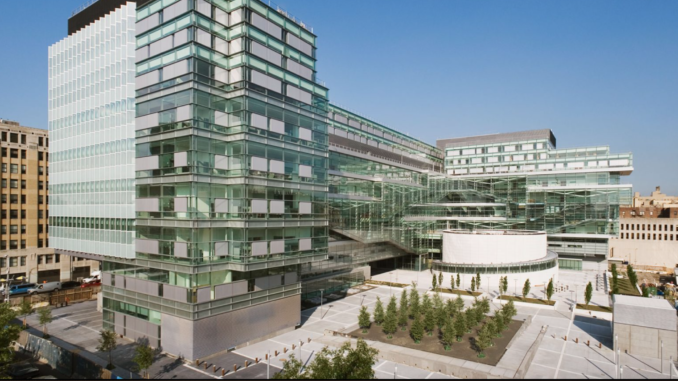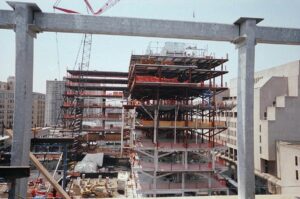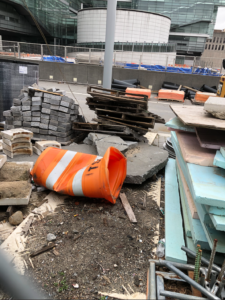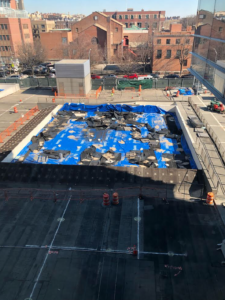
By Kevin Deutsch
[email protected]
After half a billion dollars in expenditures, a host of lawsuits, and a well-documented history of waste and mismanagement—including construction of a sprawling “public courtyard” that never opened to the public—accountability may finally be coming to the Bronx Hall of Justice.
Responding to a Bronx Justice News investigation that revealed millions in squandered taxpayer dollars and lack of oversight at the government building, City Councilman Ritchie Torres, Chairman of the New York City Council Oversight and Investigation Committee, said he is weighing an official probe into the troubled courthouse.
“We will review the reports about the Bronx Hall of Justice and determine the appropriate next steps and if a referral for investigation is warranted,” Raymond Rodriguez, a spokesman for Torres, said on Saturday.
The Bronx Councilman’s vow marks the first time a city official has said they would examine the litany of issues plaguing the postmodernist courthouse on East 161st Street, which opened in 2008 after more than $100 million in cost overruns and three years of delays.

The lowest-bidding contractor on the project was disqualified for suspected mob ties, and problems have been piling up ever since. Among them: a structurally compromised, underground parking garage inspectors once said was in danger of collapse; supposedly bomb and bullet-proof glass panels that routinely break; roof and sewage leaks, flooding, mold, power outages, a mice infestation, broken elevators and escalators; and involvement in a host of lawsuits involving more than 30 parties, from state agencies and architects to engineers and construction contractors.
In an investigation published last week, Bronx Justice News revealed the latest example of government waste at the property: The building’s civic plaza—conceived as an “open and engaging” public space where visitors could take a break from legal matters—remains closed to the public. The unused space is costing taxpayers millions in maintenance and repair expenditures, and is unlikely to ever see public use unless an array of safety issues are addressed, critics say.
The open air courtyard-cum-plaza—originally hailed as a symbol of the justice system’s transparency—has instead come to symbolize less noble hallmarks of the city bureaucracy: government waste, lax oversight, and poor planning.

Well before the courthouses’s first day of operations, court officers responsible for ensuring the safety of visitors to the courtyard saw potential for disaster: Weapons, drugs, and other illegal items could easily be tossed over the plaza exterior from adjoining streets; rocks and other projectiles could be hurled at the building’s glass exterior (the Hall of Justice also features a rooftop rock garden, which, like the civic plaza, has never opened to the public); staffing levels were insufficient to properly patrol and monitor the courtyard; and not a single metal detector had been installed at plaza entry points, meaning smuggled items could easily be brought inside.
More than a decade has passed since those concerns were first raised, yet the city does not appear to have taken any steps to address them.
“The same security issues which were stated back then exist today,” Lucian Chalfen, Director of Public Information for New York Courts, told Bronx Justice News. “Actually more so with the increased gang activity in the area over the past five years. The ability for people to congregate, secrete weapons and cause mischief remains.”
Patrick Cullen, President of the New York State Supreme Court Officers Association, said the plaza is not even close to ready for a public opening.
“This is just the latest in a litany of missteps by the city in creating this courthouse,” Cullen said. “The courtyard is a large area and we don’t have anywhere near the number of people necessary to make sure it’s safe.”
“There are a lot of blind spots in that yard. It doesn’t take just one person to walk in and look around,” Cullen added.
The Hall of Justice, which houses the borough’s Supreme Court, is owned and maintained by the city, with the Department of Citywide Administrative Services responsible for day-to-day facilities management.
Far from the idyllic, modernistic space DCAS assured the public would be open by the end of 2009–complete with evergreen trees and a pedestrian footpath—the plaza today is a desolate, garbage-strewn construction site, much of it covered in tarp and dust.

The courtyard sits atop the courthouse’s underground parking garage, which remained closed for years due to structural problems that, at one point, placed it in danger of collapse.
The waterproofing project, intended to protect the garage’s ceiling, began in October 2016, according to Ian Michaels, Executive Director of Public Information for the City’s Department of Design and Construction, which is overseeing the work.
The effort is costing the city about $5.5 million—part of a $40 million project to address a host of problems at the Hall of Justice. Among them: issues with the building’s heating, cooling, and ventilation systems, as well as “conditions that are causing interior glass to break, removal and replacement of defective paint, repair of damaged ductwork in the garage area, and rehabbing of the building’s sewer line and plumbing vent line,” Michaels said.
Despite repeated requests, DCAS officials would not go on record to discuss the security concerns of court officials, or provide a timeline for when the courtyard might eventually open to the public.
“The courtyard remains closed because the work on the site has not yet been completed,” said Nick Benson, Deputy Communications Director for the agency.

Widely considered an architectural masterpiece, the $421 million Hall of Justice stands nine stories, spans two-and-a-half city blocks, and occupies 775,000-square-feet in what was, until recently, a blighted neighborhood.
Designed by renowned architect Rafael Viñoly, its arrival helped spur economic revitalization in the surrounding community: a bustling Starbucks recently opened across the street, a craft beer bar set up shop around the corner, and rents are rising amid a local construction boom, even as gun violence, poverty, and gang-related crime continue to plague the area.
But behind the building’s gleaming exterior lay a troubling history—one that began almost as soon as Mayor Rudolph Giuliani broke ground on the project in August 2001.
City officials, including former Bronx Councilman G. Oliver Koppell, called for an official city investigation of the project. But one has ever been opened.
The project’s construction manager, Bovis Lend Lease, used numerous contractors at the site. The company, one of the world’s largest construction firms, admitted to a massive over billing scheme on New York projects in 2012. They were hit with $56 million in fines and restitution fees as a result.
A different company, Hill International, handled the project’s the final phase.
The primary contractor for the ongoing courtyard work is Lanmark Group Inc., of Brooklyn, Michaels said.
“While the building, from a design point, looks impressive, its daily functionality obviously is still problematic,” Chalfen said.
Sasha Gonzales and Eric Klein contributed reporting.
